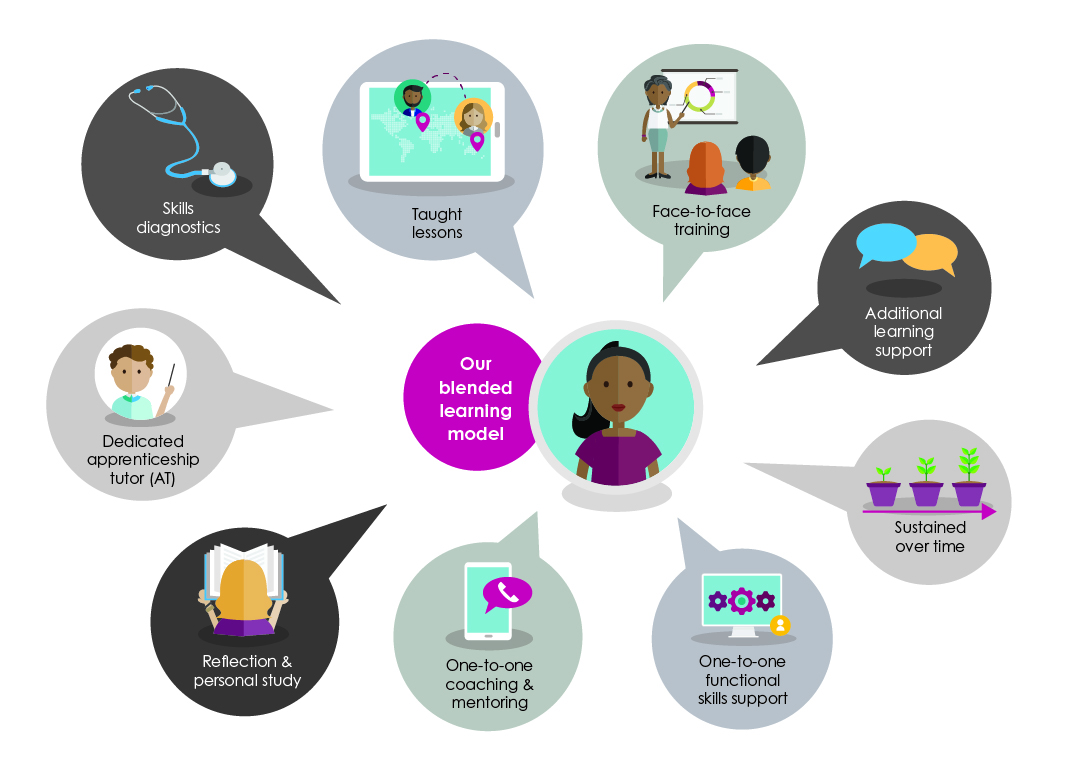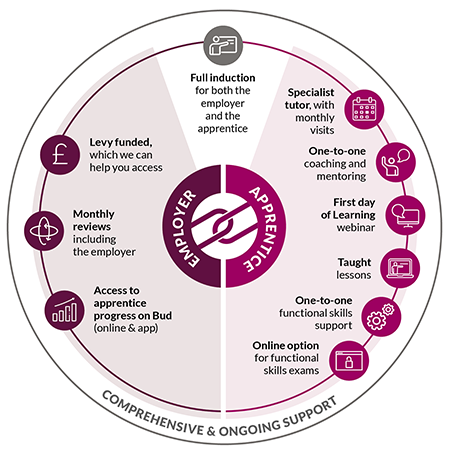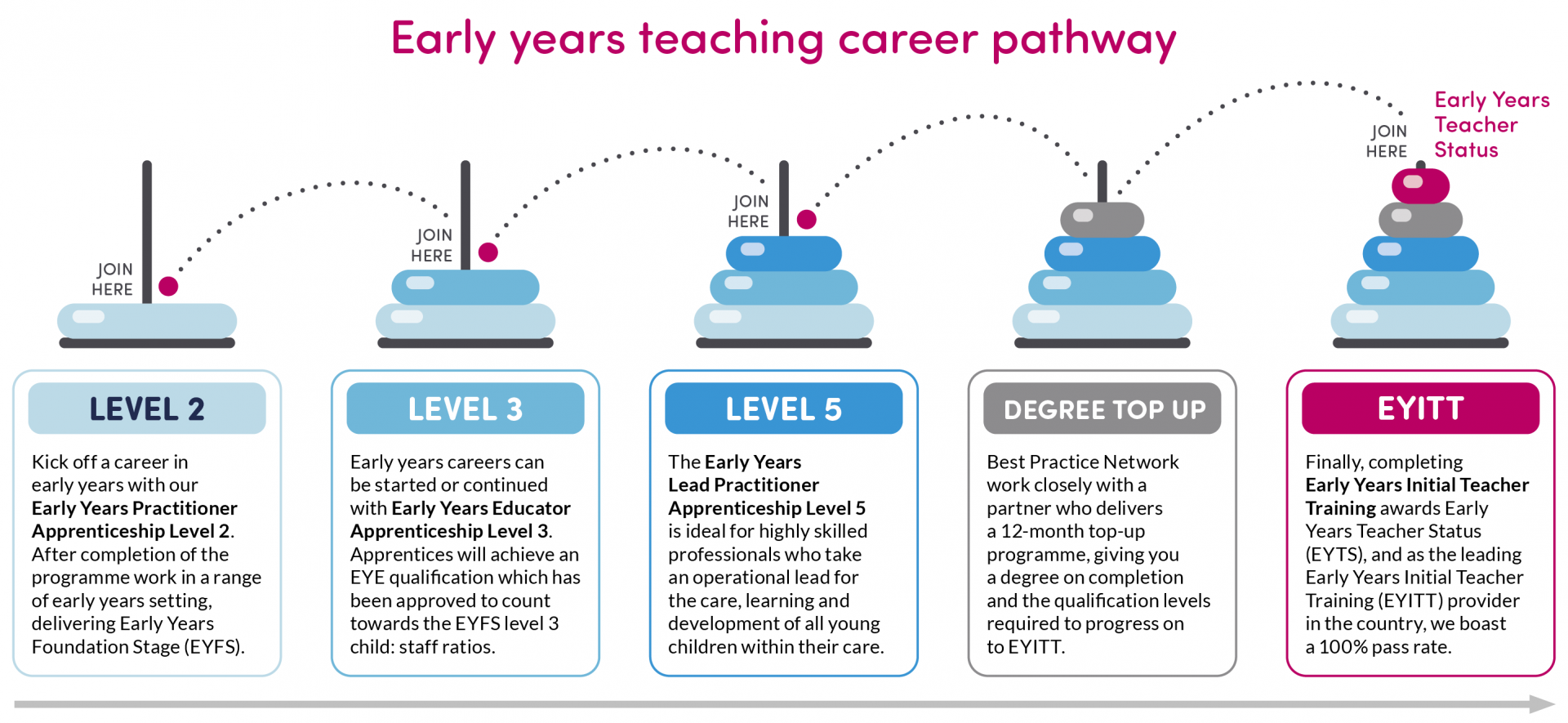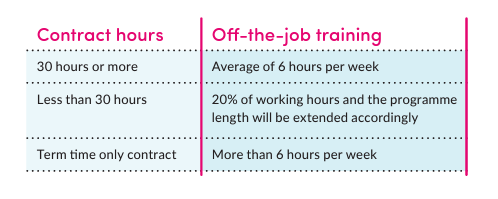Early Years Practitioner Apprenticeship Level 2
An Early Years Practitioner (EYP) works in a range of early years settings delivering the Early Years Foundation Stage (EYFS), including full day care, children’s centres, playgroups, pre-schools, nursery schools, reception classes and home-based provision.
Next deadline to apply
Closes at midnight on 13th of August
Apply Now Download Course GuideUp to 100% funded by the Apprenticeship Levy, see below for more details
At a glance
Course duration
12 - 14 Months
EYP
Level 2
In-house tutor
visits
Online training events
One-to-one coaching
What are the benefits?
The Level 2 Early Years Practitioner apprenticeship is a funded work-based training programme.
Work under the guidance and supervision of an Early Years Educator, teacher or other suitably qualified professional in the Early Years Workforce supporting the planning and delivery of the educational programmes for children in the 0-5 age range.
- A high level of support with monthly tutor visits and taught lessons
- Safeguard and promote the health, safety and welfare of children
- Support and promote children's early education and development
- Develop effective and informed practice
- Levy-funded, which we can help you access
- Career progression opportunity on completion with our EYE Level 3 Apprenticeship
- You are entitled to a TOTUM student discount card
“The thing that stood out most for me is just how organised it all is, everything that I need to find is easily accessible. Furthermore, after completing tasks, the quality of the responses from the tutors has been excellent, the whole package is really well organised.”
Ben Wright | Apprenticeship Candidate
Who is it for?
- Ideal for someone looking to pursue a career as an Early Years Practitioner, Nursery practitioner, Classroom assistant.
- Suitable for either someone already working in or someone looking for a career in, an early years childcare and education setting.
How is it delivered?
- This programme has monthly start dates – it does not run as per the typical academic year.
- Work is submitted using Bud, the cutting-edge online platform, which is easy to use and includes login access for employers to keep track of their apprentice’s progress.
Delivery includes:
- Monthly online training events to deliver Knowledge elements.
- Half termly review meetings with Apprenticeship Tutor.
- Regular Observations with Apprenticeship Tutor/mentor to evidence skills.
- Witness statements to evidence behaviours.
Our delivery model is a blended learning model consisting of the following components:

There are no previous qualifications needed for this course and no age restrictions.
Apprentices must have:
- Support from your employer and levy account holder
- Be able to complete Level 1 English and maths whilst on programme
- Successful interview
- Must have held a residency in the UK for the last three years
- Candidates must be working and interacting on a daily basis with children in the birth to 5 age range in accordance with the EYFS, the setting must be delivering the EYFS learning and development requirements
- This 14-month apprenticeship costs £4,000 but can be delivered at no cost to you or your setting if your setting is an Apprenticeship Levy payer.
- If your setting doesn’t pay into the Apprenticeship Levy Fund, the government will pay 95% of your fees, with your setting contributing just 5%, which is £200. More details can be found on the Government website.
- Contact our friendly apprenticeship team to confirm the availability of funding for your setting.
Employer Incentive
An employer incentive payment of £1,000 is available for new apprentices aged 16 to 18 and those under 25 with an Education, Health and Care Plan.
Apprenticeship Levy Transfer
If an employer pays into the Apprenticeship Levy and has unspent funds, they can transfer up to 25% of that contribution to another employer. That means you can benefit from the levy-contributions of a different organisation to cover the full costs of an apprenticeship for a member of your team.
Organisations who are actively willing to transfer unspent funds can be viewed on the pledge page. Learn more about the Apprenticeship Levy Transfer on the Government website.
Are you looking to do an apprenticeship?
If you are employed within a setting...
Please check that your employer is supportive of you going on programme and then apply directly here. When you submit an application with your setting’s details, an employer declaration will automatically be sent across for them to complete.
Apply Now
If you are not employed within a setting...
Please look at our list of vacancies that we are currently recruiting for throughout the country. Our recruitment team will then be in touch to book an online screening interview. If you are deemed successful at this stage, your details will be sent to the employer, who will then decide whether to book you in for an in person formal interview or work trial.
Find an Apprenticeship
If you do not find a vacancy which is within your area, do not worry!
Simply apply for our programme here and our recruitment team will be in touch to book an online screening interview. If you are deemed successful at this stage, we will support you in finding a setting local to you.
Apply Now
Are you an employer and looking for an apprentice?
If you are interested in upskilling some of your current staff members by supporting them on an apprenticeship, please ask them to apply via our Apprenticeship Recruitment.
If you are looking for apprentices and would like us to recruit possible candidates in your area, please fill out our vacancy form below. This information will allow us to populate your vacancy altered uniquely to your setting.
In order for us to be able to recruit on your behalf….
- Every week, our recruitment team will collect applications that come through for your vacancy. Candidates will be invited for a vigorous screening interview to find out if they are suitable for the role and to be put on programme.
- Successful candidates will be sent over with their CV, application and interview notes for you to make a decision whether you would like to invite them in for a formal interview and/or work trial.
Once they are given an offer and accepted onto the programme...
- For us to be able recruit for you and secure funding for your apprentices, you will be required to set up a Digital Apprenticeship Service Account. This is a government portal that allows you to get funding for apprenticeship costs and recruit apprentices via the government website.
- Once you have signed up you will need to add Best Practice Network as your training provider and set us permissions to recruit apprentices and add apprentice records. Once this is completed, we will be able to recruit apprentices on your behalf and secure apprenticeship funding.
We will provide all instructions on how to complete this and our dedicated funding and recruitment support teams are happy to book in a meeting with you, to provide further support and help set up your account.
Why choose us?
| Supporting employers | Supporting apprentices |
|---|---|
| We recognise how important it is to you that you find apprentices who are the best fit for your early years setting, that they have ongoing support and that you know how they are progressing at every step. | By joining the Best Practice Network apprentice programme, the apprentice can be assured that they will be supported every step of the way to succeed, both within the programme and in their career. |

FAQs:
Early Years Practitioner Apprenticeship Level 2
An apprenticeship is a job with an integrated formal training program.
Apprenticeships are work-based training programmes that are designed to help employers and individuals train for specific job roles. Apprentices get a paying job with valuable training while working towards a nationally recognised apprenticeship standard.
Both new and existing staff may embark on an apprenticeship.
Anyone in a job role who will benefit from substantial new learning to carry out the role.
We will support employers and applicants to recruit and fill positions.
- No age restrictions
- Cannot be on any other apprenticeship or programme funded by the AEB or DfE.
- Able to achieve Level 1 English and maths whilst on programme (specific rules for those with an EHCP).
- All Level 2 apprentices are required to sit Level 1 Functional skills but they do not have to have achieved them.
There are residency conditions: https://www.gov.uk/guidance/apprenticeship-funding-rules-for-employer-providers/annex-a-eligibility-criteria-who-we-fund
The apprentice is paid a lawful wage (minimum of £5.28 per hour from April 2023)
The apprentice cannot contribute towards the cost of the apprenticeship
An initial assessment must consider whether the individual already possesses any of the training content e.g. the knowledge, skills and behaviours required by the apprenticeship:
- It is important to know the apprentice’s starting point so that the training plan does not duplicate prior learning.
- Any existing relevant qualifications will be checked against the Apprenticeship Standard criteria during the initial assessment to ensure there is no duplication.
- Significant new learning must be required.
Only knowledge, skills and behaviours in the Apprenticeship Standard are relevant, existing non-relevant qualifications at the same or higher level do not exempt learners from the programme, e.g. a degree in landscape design when completing a Level 3 Early Years Educator Apprenticeship.
12 months on programme plus End Point Assessment.
- L2 Early Years Practitioner Apprenticeship
- NCFE CACHE Level 2 Diploma for the Early Years Practitioner
-
Monthly face to face training with the Apprenticeship Tutor in the workplace (Covid allowing) to deliver Knowledge elements
-
8 week review meetings with Apprenticeship Tutor
-
Monthly Observations with Apprenticeship Tutor/mentor to evidence skills
-
Reflective accounts and work products confirmed by witness statements to evidence behaviours
-
One to one maths and English tuition if required
The apprenticeship is a work-based qualification, which means that the majority of the training and assessment for the apprenticeship will be completed at your workplace. You will need to build an apprenticeship e-Portfolio of evidence. Your Apprenticeship Tutor will observe you in the workplace and guide you on which pieces of work-based evidence are suitable for your e-Portfolio.
Delivery will also be through webinars, online courses and face to face training days with the dedicated apprenticeship tutor (dependant on current legislation).
Throughout your apprenticeship you will have face to face visits (dependant on current legislation and guidance from BPN and your workplace) with your Apprenticeship Tutor to carry out reviews and observations and support you and your employer.
Once you have completed all the criteria for the apprenticeship and mock tests you will have a gateway meeting with your Tutor and Line Manager/Mentor to agree you are ready for your End Point Assessment (EPA). The EPA is completed to assess the knowledge, skills and behaviours that you have learnt throughout the apprenticeship.
-
Early Years Practitioner Qualification (level 2)
-
English & Mathematics at Level 1, and Level 2 attempted
-
Professional discussion underpinned by portfolio – 90 minutes and ten questions
-
Knowledge test 40 multiple choice questions
As an apprentice you must be paid at least the Apprenticeship Minimum Wage of £5.28 an hour from April 2023.
If you are 19 after completing the first year of your apprenticeship, you must be paid at least the full National Minimum Wage.
All apprentices are employed and have a contract of employment. You are counted as a regular employee so get all the benefits such as holiday and sick leave as well.
It is up to you what you do when you have finished your apprenticeship. There may be an opportunity to stay on at the same company and progress to the next level of apprenticeship or you may want to look for a new job or professional development opportunity.
For example, on completing the Level 2 Apprenticeship your employer may wish to support you on to the Level 3 Early Years Educator Apprenticeship.
Email: EYApprenticeships@bestpracticenet.co.uk telling us your name, phone number and location and we will arrange a call to discuss your options and to support you towards finding an apprenticeship.
Any current vacancies will be advertised on the National Apprenticeship Service at https://www.gov.uk/apply-apprenticeship
Yes, apprentices can move employers but they must check that the new employer is happy to support them on the programme and the employer will need to complete checks and contracts with us first.
For the apprenticeship, a certain amount of your working hours should be focused on gaining new learning. The amount will be dependent on your contracted hours per week.
- Off-the-job training is about upskilling an individual to reach full occupational competency, not accrediting their existing skills.
- Off-the-job training must be away from the apprentice’s normal working duties and must teach new knowledge, skills and behaviours relevant to their specific apprenticeship.
- You can deliver off-the-job training in the apprentice’s normal workplace or at an external location.
- Progress reviews and on-programme assessment do not count towards off-the-job training.
- Apprentices may choose to spend additional time training outside paid hours, but this must not be required to complete the apprenticeship.
- If training must, by exception, take place outside of the apprentice’s normal working hours, e.g. in an evening or at a weekend for an apprentice that normally works Monday to Friday between 9-5, we would expect this to be recognised, for example through time off in lieu or by an additional payment to the apprentice.
Benefits of Off-the-job training
Apprenticeships are about upskilling an individual. Reaching occupational competency takes time.
- Many employers and apprentices have praised the positive effect off-the-job training has on their productivity
- Apprentices feel valued by the significant investment in their training.
- It can be delivered flexibly, for example, as a part of each day, one day per week, one week out of five or as block release.
- You may already have existing training programmes or materials you can use to deliver elements of the apprentice’s off-the-job training.
- We have developed a range of delivery styles to suit employer and apprentice needs. Employers should work with us to decide when and where off-the-job training should take place and who is best placed to deliver it.
- Learning support - To be successful, learners may need a range of approaches and support, which will be targeted appropriately. As well as material assistance, such as physical adjustments or access to accessibility software, some apprentices may benefit from additional time, revision or personal support from their training provider, to help them to stay on track and to achieve specific knowledge, skills and behaviours.
- Develops strategic leadership skills and behaviours
- Improves core management techniques
- Focused learning experience
- Builds leadership capabilities to motivate and inspire your teams
- Builds self-awareness
- Addresses real organisational issues
- For those that are engaged on an apprenticeship there may be an initial loss of productivity, due to the time the apprentice is engaged in training, but in the long term the new skills that the person brings back to the workplace, which makes them fully occupationally competent, should compensate for this.
- The importance of off-the-job training to a quality apprenticeship was emphasised in the Richard Review of Apprenticeships and more recently in Taking Training Seriously, a report by the Gatsby Foundation which compared English apprenticeships to those in other countries. This report reinforced the need for off-the-job training and concluded that 20% should be the bare minimum if England is to compete with the strongest apprenticeship programmes internationally.
- Ofsted and the Quality Assurance Agency for Higher Education (QAA) have also highlighted the importance of off-the-job training to a quality apprenticeship in their various publications.
- A key element of Ofsted’s inspection regime is a judgement about how well apprentices make progress from their starting points i.e. what an apprentice can do as a result of their training and experience on the apprenticeship programme that they were unable to do before.
Off-the-job training examples
- Research
- Networking events
- Seminars
- Shadowing others
- Employer induction programme, e.g. conflict resolution and corporate induction as these are part of the required knowledge.
- Reflective learning
- Self-directed distance learning (where the apprentice is working on their own with no real-time support)
- Interactive online learning (virtual classrooms where the learner can receive support, in real-time, from their training provider).
- Practical training
- Mentoring
- Time writing assignments
- Lectures, role-playing, simulation exercises
- Online learning
- Industry visits
- Learning support

Funding
- This 14-month apprenticeship costs £4,000 but can be delivered at no cost to you or your setting if your setting is an Apprenticeship Levy payer.
- If your setting doesn’t pay into the Apprenticeship Levy Fund, the government will pay 95% of your fees, with your setting contributing just 5%, which is £200. More details can be found on the Government website.
- Contact our friendly apprenticeship team to confirm the availability of funding for your setting.
Employer Incentive
Apprenticeship Levy Transfer
If an employer pays into the Apprenticeship Levy and has unspent funds, they can transfer up to 25% of that contribution to another employer. That means you can benefit from the levy-contributions of a different organisation to cover the full costs of an apprenticeship for a member of your team.
Organisations who are actively willing to transfer unspent funds can be viewed on the pledge page. Learn more about the Apprenticeship Levy Transfer on the Government website.
Apprenticeship funding is available for employers from the government. The size of the funding employers receive varies depending on whether they pay the apprenticeship levy or not. Non-levy paying companies currently pay 5% of the cost with the government paying the rest. For levy-paying employers the funds are drawn from their levy accounts or topped up by the government if they have insufficient funds.
https://www.apprenticeships.gov.uk/employer/how-much-is-it-going-to-cost
- The entire apprenticeship is eligible for funding
- The apprentice cannot pay towards an apprenticeship
- Resits may incur extra costs to the employer
Payments are spread across the entire lifetime of the apprenticeship - taken each month by your training provider. This means that you don’t have to meet the full cost of the apprenticeship at the start of the training. You just need enough funds in your account to meet the monthly payments. In addition, 20% of the cost of the apprenticeship will be held back and taken from your Apprenticeship Service (AS) online account at the end of the apprenticeship.
Do Levy funds run out?
Yes. Levy funds will expire 24 months after they enter your digital account unless you spend them on apprenticeship training. For example, funds that entered your account in July 2019 will expire in July 2021. If you don’t use them, you will lose them. The account works on a first-in, first-out basis. Whenever a payment is taken from your digital account it automatically uses the funds that entered your account first.
What happens if an employer’s Levy funds don’t cover the full cost of training?
If an employer pays the Apprenticeship Levy but their funds do not cover the full cost of the apprenticeship training, then additional support is available. The government will pay 95% of the additional costs (up to the maximum of the relevant funding band) -with you as the employer ‘co-investing’ 5%.
As part of our Early Years initiative, learners who wish to become early years professionals, or those already working in this area of education, can take part in our programmes and advance onto other qualifications related to early years and child care. This initiative supports you in achieving your own ambitions and allows you to gain the skills required to support the next generation in being able to reach theirs.
Our Early Years Career Pathway has been developed to support your career development, take into account the variety of roles within the early years sector, and help you develop your career.
This pathway includes the following programmes: Early Years Practitioner (EYP) Apprenticeship Level 2, Early Years Educator (EYE) Apprenticeship Level 3, Early Years Lead Practitioner (EYLP) Level 5 and Early Years Initial Teacher Status (EYIIT) (eligible with a degree top-up).

Related Courses and Content
Early Years Educator Level 3
Early Years Educators work with and care for children from birth to 5 years. They play a massive role in supporting children to have the best start to their education.
Course
Early Years Lead Practitioner Level 5
These highly skilled professionals take an operational lead for the care, learning and development of all young children within their care and lead and support the practice of others.
Course
EY SENCO Level 3
For a level 3 practitioner in a private, voluntary or independent setting. It is also appropriate for Ofsted-registered childminders and Ofsted-registered childminder agencies.
Course


.jpg)

